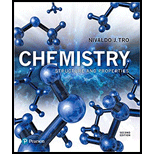
Concept explainers
Refer to the Kspvalues in Table 17.2  to calculate the molar solubility of each compound in pure water.
to calculate the molar solubility of each compound in pure water.
- AgBr
- Mg(OH)2
- CaF2
Table 17.2 Selected Solubility-Product Constants (Ksp) at 25 ?C
| Compound | Formula | Ksp | Compound | Formula | Ksp |
| Barium fluoride | BaF2 | 2.45 × 10−5 | Lead(II) chloride | PbCl2 | 1.17 × 10−5 |
| Barium sulfate | BaSO4 | 1.07 × 10−10 | Lead(II) bromide | PbBr2 | 4.67 × 10−6 |
| Calcium carbonate | CaCO3 | 4.96 × 10−9 | Lead(II) sulfate | PbSO4 | 1.82 × 10−8 |
| Calcium fluoride | CaF2 | 1.46 × 10−10 | Lead(II) sulfide | PbS | 9.04 × 10−29 |
| Calcium hydroxide | Ca(OH)2 | 4.68 × 10−6 | Magnesium carbonate | MgCO3 | 6.82 × 10−6 |
| Calcium sulfate | CaSO4 | 7.10 × 10−5 | Magnesium hydroxide | Mg(OH)2 | 2.06 × 10−13 |
| Copper(II) sulfide* | CuS | 1.27 × 10−36 | Silver chloride | AgCl | 1.77 × 10−10 |
| Iron(II) carbonate | FeCO3 | 3.07 × 1011 | Silver chromate | Ag2CrO4 | 1.12 × 10−12 |
| Iron(II) hydroxide | Fe(OH)2 | 4.87 × 10−17 | Silver bromide | AgBr | 5.36 × 10−13 |
| Iron(II) sulfide* | FeS | 3.72 × 10−19 | Silver iodide | AgI | 8.51 × 10−17 |
*Sulfide equilibrium is of the type:
Want to see the full answer?
Check out a sample textbook solution
Chapter 17 Solutions
Solutions Manual For Chemistry: Structure And Properties
Additional Science Textbook Solutions
College Physics: A Strategic Approach (3rd Edition)
Fundamentals of Physics Extended
Campbell Biology in Focus (2nd Edition)
Organic Chemistry (8th Edition)
General, Organic, and Biological Chemistry - 4th edition
- Don't used hand raiting and don't used Ai solutionarrow_forwardDon't used Ai solution and don't used hand raitingarrow_forwardOA. For the structure shown, rank the bond lengths (labeled a, b and c) from shortest to longest. Place your answer in the box. Only the answer in the box will be graded. (2 points) H -CH3 THe b Нarrow_forward
- Don't used hand raitingarrow_forwardQuizzes - Gen Organic & Biological Che... ☆ myd21.lcc.edu + O G screenshot on mac - Google Search savings hulu youtube google disney+ HBO zlib Homework Hel...s | bartleby cell bio book Yuzu Reader: Chemistry G periodic table - Google Search b Home | bartleby 0:33:26 remaining CHEM 120 Chapter 5_Quiz 3 Page 1: 1 > 2 > 3 > 6 ¦ 5 > 4 > 7 ¦ 1 1 10 8 ¦ 9 a ¦ -- Quiz Information silicon-27 A doctor gives a patient 0.01 mC i of beta radiation. How many beta particles would the patient receive in I minute? (1 Ci = 3.7 x 10 10 d/s) Question 5 (1 point) Saved Listen 2.22 x 107 222 x 108 3.7 x 108 2.22 x 108 none of the above Question 6 (1 point) Listen The recommended dosage of 1-131 for a test is 4.2 μCi per kg of body mass. How many millicuries should be given to a 55 kg patient? (1 mCi = 1000 μСi)? 230 mCiarrow_forwardDon't used hand raiting and don't used Ai solutionarrow_forward
- Don't used hand raiting and don't used Ai solutionarrow_forwardQ3: Arrange each group of compounds from fastest SN2 reaction rate to slowest SN2 reaction rate. CI Cl H3C-Cl CI a) A B C D Br Br b) A B C Br H3C-Br Darrow_forwardQ4: Rank the relative nucleophilicity of halide ions in water solution and DMF solution, respectively. F CI Br | Q5: Determine which of the substrates will and will not react with NaSCH3 in an SN2 reaction to have a reasonable yield of product. NH2 Br Br Br .OH Brarrow_forward
- Classify each molecule as optically active or inactive. Determine the configuration at each H соон Chirality center OH 애 He OH H3C Ноос H H COOH A K B.arrow_forwardQ1: Rank the relative nucleophilicity of the following species in ethanol. CH3O¯, CH3OH, CH3COO, CH3COOH, CH3S Q2: Group these solvents into either protic solvents or aprotic solvents. Acetonitrile (CH3CN), H₂O, Acetic acid (CH3COOH), Acetone (CH3COCH3), CH3CH2OH, DMSO (CH3SOCH3), DMF (HCON(CH3)2), CH3OHarrow_forwardDon't used hand raiting and don't used Ai solutionarrow_forward
 General Chemistry - Standalone book (MindTap Cour...ChemistryISBN:9781305580343Author:Steven D. Gammon, Ebbing, Darrell Ebbing, Steven D., Darrell; Gammon, Darrell Ebbing; Steven D. Gammon, Darrell D.; Gammon, Ebbing; Steven D. Gammon; DarrellPublisher:Cengage Learning
General Chemistry - Standalone book (MindTap Cour...ChemistryISBN:9781305580343Author:Steven D. Gammon, Ebbing, Darrell Ebbing, Steven D., Darrell; Gammon, Darrell Ebbing; Steven D. Gammon, Darrell D.; Gammon, Ebbing; Steven D. Gammon; DarrellPublisher:Cengage Learning Chemistry: Principles and PracticeChemistryISBN:9780534420123Author:Daniel L. Reger, Scott R. Goode, David W. Ball, Edward MercerPublisher:Cengage Learning
Chemistry: Principles and PracticeChemistryISBN:9780534420123Author:Daniel L. Reger, Scott R. Goode, David W. Ball, Edward MercerPublisher:Cengage Learning Principles of Modern ChemistryChemistryISBN:9781305079113Author:David W. Oxtoby, H. Pat Gillis, Laurie J. ButlerPublisher:Cengage Learning
Principles of Modern ChemistryChemistryISBN:9781305079113Author:David W. Oxtoby, H. Pat Gillis, Laurie J. ButlerPublisher:Cengage Learning Chemistry: The Molecular ScienceChemistryISBN:9781285199047Author:John W. Moore, Conrad L. StanitskiPublisher:Cengage Learning
Chemistry: The Molecular ScienceChemistryISBN:9781285199047Author:John W. Moore, Conrad L. StanitskiPublisher:Cengage Learning Chemistry by OpenStax (2015-05-04)ChemistryISBN:9781938168390Author:Klaus Theopold, Richard H Langley, Paul Flowers, William R. Robinson, Mark BlaserPublisher:OpenStax
Chemistry by OpenStax (2015-05-04)ChemistryISBN:9781938168390Author:Klaus Theopold, Richard H Langley, Paul Flowers, William R. Robinson, Mark BlaserPublisher:OpenStax Chemistry for Engineering StudentsChemistryISBN:9781337398909Author:Lawrence S. Brown, Tom HolmePublisher:Cengage Learning
Chemistry for Engineering StudentsChemistryISBN:9781337398909Author:Lawrence S. Brown, Tom HolmePublisher:Cengage Learning





